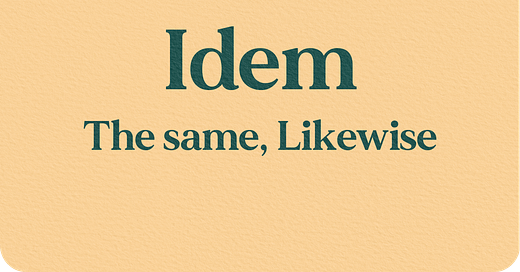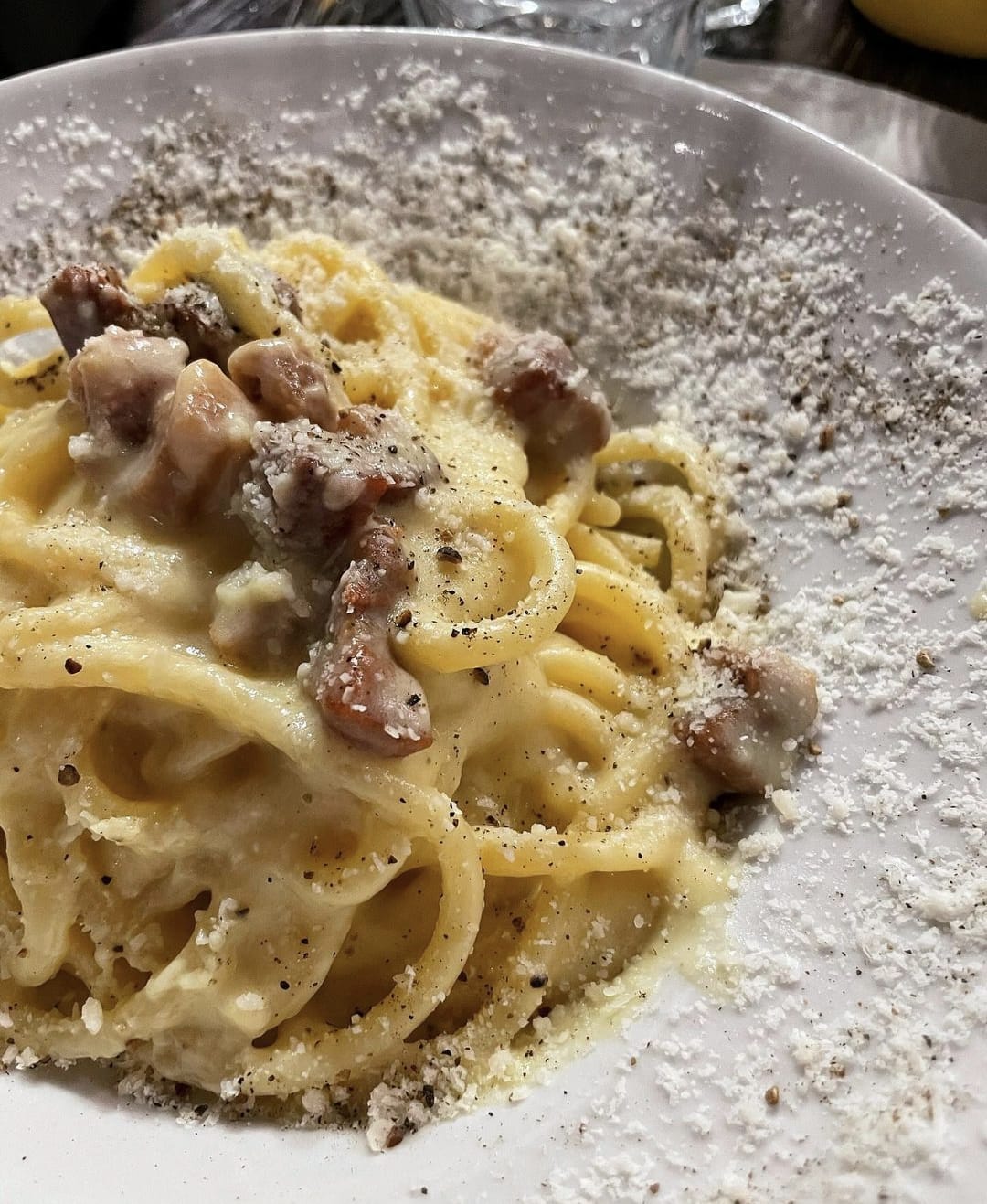🎙️ COME SI PRONUNCIA?
[EE-dem]
PRONOME LATINO
LATIN PRONOUN
The same.
🇮🇹 La stessa cosa; usato per evitare ripetizioni in elenchi, citazioni bibliografiche e simili.
🇬🇧 The same thing; used to avoid repetition in lists, bibliographic citations, and similar contexts.
Similarly, Likewise.
🇮🇹 Con valore avverbiale, significa ugualmente, pure, nello stesso modo.
🇬🇧 With adverbial value, it means similarly, likewise, in the same way.
💬 ESEMPI
A: Propongo di posticipare il progetto di una settimana.
B: Idem, il tempo è troppo poco.
A: I suggest postponing the project by a week.
B: Same here, there's too little time.
A: Prenderò le lasagne.
B: Idem, sembrano deliziose!
A: I'll have the lasagne.
B: Same here, they look delicious!
A: Come hai fatto a dimenticare il compleanno di tua mamma?!
B: Tu idem lo scorso anno, quindi hai poco da parlare…
A: How could you forget your mom's birthday?!
B: You did the same last year, so you have little room to talk...
Il Primo Ministro ha mentito sulle tasse; idem sulle pensioni.
The Prime Minister lied about taxes; likewise about pensions.
🔎 L’ORIGINE DELL’ESPRESSIONE
🇮🇹 Idem deriva dal latino, composto da is [quello] e la particella -dem, che significa "precisamente".
🇬🇧 Idem comes from Latin, composed of is [that] and the particle -dem, meaning "precisely".
🤓 LO SAPEVI CHE…
IMPRESS YOUR ITALIAN FRIENDS WITH CURIOUS FACTS ABOUT ITALY AND ITS CULTURE
🇮🇹 Carbonara con le patate
Ieri sera ero fuori con degli amici stranieri in visita a Roma e li ho portati al ristorante per assaggiare dei piatti tipici romani. Ho passato circa dieci minuti a tradurre il menù e a dare consigli.
Quando il cameriere è arrivato per prendere le ordinazioni, ho aspettato che gli ospiti ordinassero per primi.
Ivy: “Carbonara”.
Felipe: “Carbonara”.
Eriko: “Carbonara”.
Quando è toccato a me ho detto: “Idem con patate. E anche un tagliere misto da condividere, per piacere.”
Il cameriere ha scritto tutto sul suo quadernetto, ha ripreso i menù ed è andato in cucina.
Quando ho incrociato nuovamente lo sguardo dei miei amici, ho notato lo stupore nei loro occhi, misto al sentimento di essere stati traditi. Potevo leggere i loro pensieri, nell’ordine:
Esiste la carbonara con le patate?!
Se è più buona di quella normale, perché non ci ha detto nulla nei dieci minuti in cui ha spiegato il menù?
Ho cercato di trattenere una risata vedendo i loro volti confusi. "Tranquilli," ho detto, "non esiste la carbonara con le patate. È solo un modo di dire."
I loro sguardi sono passati dalla confusione al sollievo, ma la curiosità era evidente. "Ma allora cosa hai ordinato?" ha chiesto Eriko.
"Ho ordinato la carbonara, come voi," ho spiegato. "L'espressione 'idem con patate' è un modo scherzoso per dire 'la stessa cosa', ma con un po' di enfasi in più."
Visto che in quel ristorante impiegano circa 20 minuti per cucinare la carbonara, ho colto l'occasione per raccontare loro l'origine di questa curiosa espressione.
"Dalla metà dell’Ottocento, nei menù dei ristoranti e delle trattorie italiane, dato che il piatto principale veniva modificato raramente e quello che cambiava era il contorno, per risparmiare spazio sul menù si usava la parola 'idem' per indicare lo stesso piatto ma con un contorno diverso. Le patate erano uno dei contorni più comuni, quindi capitava spesso di vedere scritto 'idem con patate'."
I miei amici ascoltavano attenti, iniziando a capire. "Col tempo," ho continuato, "questa frase è uscita dai menù ed è entrata nel linguaggio comune come modo scherzoso per dire 'la stessa cosa', ma sottolineando la ripetitività e poca fantasia."
"Gli italiani invece" ha detto Felipe, "hanno troppa fantasia in fatto di detti e modi dire. È veramente difficile capirli tutti.”
Per il resto della cena, abbiamo continuato a parlare di espressioni idiomatiche italiane, confrontandole con quelle dei loro Paesi (e ci sono detti divertentissimi in tutte le lingue del mondo!). È stato un modo interessante per esplorare le sfumature che difficilmente si imparano quando si studia una lingua straniera.
PS: La carbonara era eccellente. E il tagliere… idem!
Qual è un'espressione nella tua lingua divertente e difficile da capire? Scrivi nei commenti o a ciao@giulia.school 😊🇬🇧 Carbonara with potatoes
Last night I was out with some foreign friends visiting Rome, and I took them to a restaurant to taste typical Roman dishes. I spent about ten minutes translating the menu and giving advice. When the waiter arrived to take our orders, I waited for the guests to order first.
Ivy: "Carbonara".
Felipe: "Carbonara".
Eriko: "Carbonara".
When it was my turn, I said: "Idem with potatoes. And also some charcuterie to share, please."
The waiter wrote everything down in his notebook, took back the menus, and went to the kitchen. When I met my friends' gaze again, I noticed the amazement in their eyes, mixed with a feeling of betrayal. I could read their thoughts, in order:
Does carbonara with potatoes exist?!
If it's better than the regular one, why didn't he tell us anything in the ten minutes he spent explaining the menu?
I tried to hold back a laugh seeing their confused faces. "Don't worry," I said, "carbonara with potatoes doesn't exist. It's just a saying."
Their looks changed from confusion to relief, but curiosity was evident. "So what did you order?" Eriko asked. "I ordered carbonara, like you," I explained. "The expression 'idem with potatoes' is a playful way to say 'the same thing', but with a bit more emphasis."
Since in that restaurant it takes about 20 minutes to cook carbonara, I took the opportunity to tell them the origin of this curious expression.
"From the mid-19th century, in Italian restaurant and trattoria menus, since the main dish was rarely modified and what changed was the side dish, to save space on the menu, they used the word 'idem' to indicate the same dish but with a different side. Potatoes were one of the most common sides, so it was often written 'idem with potatoes'."
My friends listened attentively, starting to understand.
"Over time," I continued, "this phrase left the menus and entered common language as a playful way to say 'the same thing', but emphasizing repetitiveness and lack of imagination."
"Italians, on the other hand," Felipe said, "have too much imagination when it comes to sayings and idioms. It's really difficult to understand them all."
For the rest of the dinner, we continued to talk about Italian idiomatic expressions, comparing them with those from their countries (and there are hilarious sayings in all languages of the world!). It was an interesting way to explore the nuances that are difficult to learn when studying a foreign language.
PS: The carbonara was excellent. And the charcuterie... idem!
👉 YOUR TURN
Can you use the word IDEM correctly in a sentence?
Based on the definition and examples provided, write a sentence using today's word of the day and share it as a comment on this post. It is important that your sentence makes sense and shows that you understand the word's definition, but we also encourage you to use creativity and have fun.





Sono italiano? Sì.
Ho letto tutto il blog? Sì.
Mi è piaciuto? Sì.
Conoscevo l'origine di idem con patate? No.
Ho idea di come io ci sia arrivato? Nessuna, ma grazie Substack.
I have never considered lasagne (or any pasta) as plural in English even if it is inherently plural.
"Do you fancy some pasta?
A: I'll have the lasagne/spaghetti/gnocchi/ravioli
B: Me too, it looks delicious!